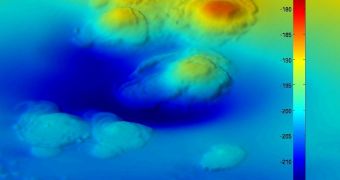Marine researchers are perfectly aware of the fact that the world's oceans have only revealed a minute part of their secrets thus far. Immense swaths of ocean floor are still not mapped, and only superficially studied, as the sheer size of the water-covered areas makes thorough surveys difficult. Still, from time to time, scientists come across new things, such as was recently the case near Santa Barbara, in the United States. A team of investigators managed to discover an array of old asphalt volcanoes, which remained hidden in the murky waters of the Pacific Ocean for at least 40,000 years.
According to the team, which was sponsored by the US National Science Foundation (NSF), the formations are found some 10 miles off coast, in a series of impressive landmark features, known collectively as the Santa Barbara Channel. The domes may have been active during the Ice Age, researchers believe. The largest of the ones discovered thus far is located 220 meters (700 feet) under the surface of the water, which may explain why it was never identified before. Scuba divers cannot swim at this level, as their bodies would need to endure enormous pressures.
The work was conducted by a team of researchers consisting of experts from the University of California in Santa Barbara (UCSB), the Woods Hole Oceanographic Institution (WHOI), the University of California in Davis (UCD), the University of Sydney, and the University of Rhode Island. Speaking about the asphalt volcanoes, David Valentine says that “They're larger than a football-field-long and as tall as a six-story building. They're massive features, and are made completely out of asphalt.” Valentine is a UCSB geoscientist, and also the lead author of the new research.
The expert and his group first found the peculiar features some 3 years ago, but continued to return and study them annually. Using submersible robots outfitted with scientific equipment, the team determined that that features must be volcanoes due to the particular flow patterns on their surfaces, which are indicative of lava flows. Most likely, they say, 30 to 40 millennia ago, petroleum flowed from the sea-floor. This data supports belief that natural oil seeps contribute significantly to the amounts of oil making its way into coastal environments.

 14 DAY TRIAL //
14 DAY TRIAL //